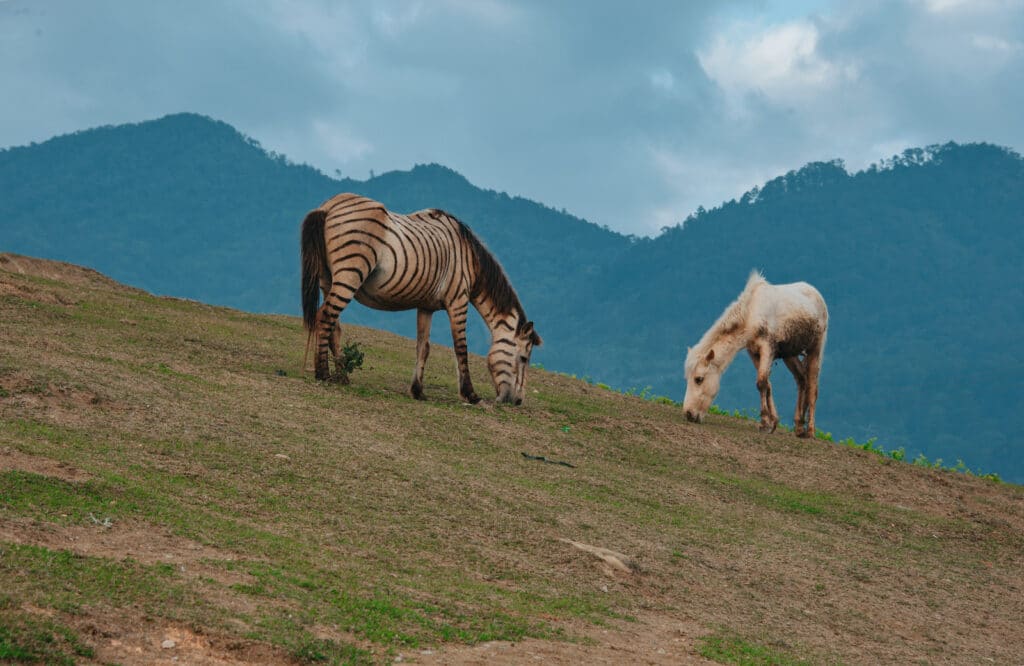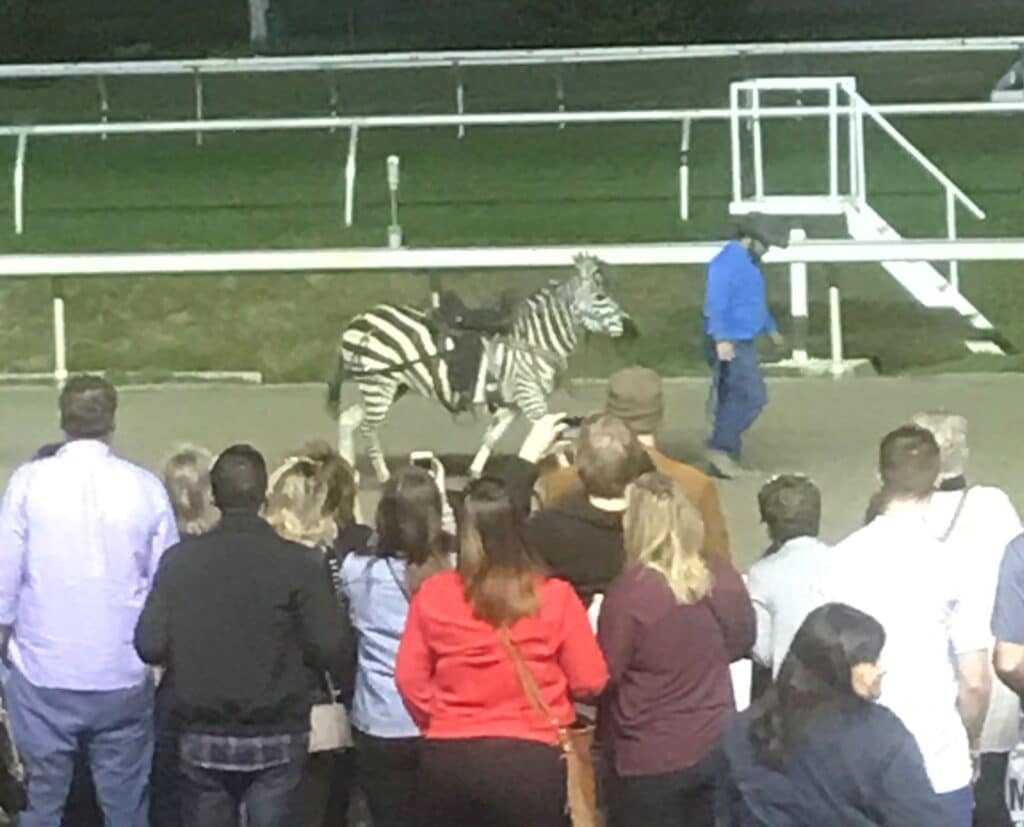Last updated: February 16, 2023
We recently attended the zebra races at the New Orleans Fairgrounds Racetrack. Seeing the zebras run amok on the racetrack made me wonder what they have in common with horses.
Horses and zebras have a lot in common; both are herbivores, herd animals, have hoofed feet, and can run fast. They also have a similar number of teeth, long heads, and manes. Zebras and horses are mammals and members of the Equidae family; however, they are different species.
Many people incorrectly think of zebras as striped horses. There are a lot of similarities but also some significant differences between horses and zebras.
Horses and zebras are hindgut herbivores.
Horses and zebras are herbivores that are hindgut fermenters; this means they only eat plants, and the extraction of energy from cellulose or fiber occurs in the animals’ cecum and colon.
The digestive systems of horses and zebras have a foregut, which is the stomach and the small intestine, and a hindgut, the cecum and colon. In the foregut, the grain is broken down by digestive enzymes in the stomach and absorbed in the small intestine.
Fibers, such as grass and hay, can’t be digested in the foregut but are passed through to the hindgut, where microorganisms process it. This process is vital to the health of horses and zebras.
In relation to their size, the stomachs of horses and zebras are small, so it’s critical to feed them small portions of the concentrated grain. When too much grain is eaten, instead of being processed in the foregut, it’s pushed to the hindgut, where it doesn’t belong.
When undigested grain makes its way to the hindgut, bad things happen, like colic, laminitis, and ulcers. These ailments are less likely to occur in zebras because they typically don’t have access to an abundant grain source.
Horses and zebras are grazers; they roam pastures and eat grass throughout the day. In Africa, wild zebras graze pasture land that’s also used to raise cattle. Some studies indicate that wild animals harm forage, while others show cattle benefit by eating with wild zebras.

Horses and zebras are prey animals.
In the wild, there are predators and prey animals, and horses and zebras are prey animals. For prey animals to survive, they have to avoid being captured by predators.
Horses and zebras spend time in herds and have developed physical traits and instincts to survive. They communicate danger with their ears; they have keen vision and can sleep on their feet.
If either animal were lying on the ground when a predator approached, it would likely lose its life. In herds, the animals take turns sleeping, so if one or two are lying down, other horses or zebras remain alert to sound an alarm if predators come into the area.
Wild zebras typically live in groups consisting of one male, several females, and their offspring. A herd of zebras is called a “Dazzle.” They groom one another, protect their members, and graze together.
Horses and zebras have hooves.
Horses and zebras are two closely related species of horse-like animals that are members of the Equidae family. They are the only group of animals with just one toe, which is in the form of a hoof.
Their hooves are critical for running and living in various environments, as they protect their feet from injury and provide a sturdy base for support. The shape and structure of their hooves can vary slightly depending on the species and their natural habitat.
Horses and zebras’ hoof walls are made of keratin, the same material as humans’ fingernails and hair. Wild horses and zebras’ hooves are extremely tough and durable.
Equids haven’t always had just one toe. Their smaller ancestors, the Hyracotherium, had four front and three back toes. As horses migrated from the forest to the grassy region, they grew larger and needed greater stability.
About five million years ago, the middle digit strengthened and grew thicker, and the animal eventually lost its outer toes.
Horses and zebras have long heads and similar teeth.
Horses and zebras have large heads with long nasal bones. And they both use their front teeth to nip off the tops of grass and then move the food to their back to crush and grind it before swallowing. They have between 40 and 42 teeth, and male zebras have sharp canines they use during fights.

Horses and zebras have manes.
The mane of a horse or zebra provides shade on hot sunny days and insulates the horse’s neck on cold days, plus it acts as a fly screen. Manes also shield the animal’s neck from a predator’s bite, and long forelocks shade its eyes from the sun and insects.
Zebras with upright manes are typically in good shape, and they have a strip of fat below their manes, which keeps their hair standing up straight. But if the animal begins to lose condition, it depletes this fat reserve, and the mane starts to fall over.
The mane is a useful indicator of fitness because zebras’ bellies stay swollen with gas and make the animal looks fat, but it could be starving.

Horses and zebras are fast.
Horses and zebras have long, thin legs and powerful hindquarters; they are built to run fast to outrun predators like bears and lions. Racehorses have been clocked running 55 miles per hour, and zebras can run over 40 miles per hour.
5 differences between horses and zebras.
Zebras have a distinctive striped color coat pattern not found in horses, but there are more differences between horses and zebras than just their coat patterns.
Zebras are smaller than horses.
One of the other apparent differences between zebras and horses is their height. Horses typically stand over 14.2 hands tall but can reach heights above 18 hands.
There are three species of zebras, and they range in size from 10 to 13 hands. Grevy zebras, which are the largest, reach 13 hands; the mountain zebra, famous for the gridiron stripes on its rump, and the Burchell’s zebra, recognized by its broad stripes, are typically ten hands tall.
Zebras have a different style of mane and tail hair than horses.
Most horse breeds have long, thick, and luxurious manes, and this is especially true of Andalusians and Friesian horses. Zebras, on the other hand, have manes of short thick hair that stick straight up from their necks.
Horses’ tail hair grows from the base of its tail, but a zebra’s tail is void of hair until it bushes out at about midway to its end.

Zebras can make more sounds than a horse.
Zebras make all the sounds of a horse plus a couple not found in the horse’s vocabulary. For instance, zebras produce a high-pitched bark identical to the sound of a small dog, and they also hee-haw like a donkey. The zebra’s bark is used to alert the herd of predators and to call out for lost members.
A zebra is built differently than a horse.
Horses have longer legs in relation to their body than zebras. Horses have whithers and a sloping back, perfect for fitting a saddle. Zebras have no withers, and their back is straight, more like a donkey than a horse.
Zebras are mean.
Zebras may look peaceful grazing open ranges, but under their calm exterior is a warrior. They fight each other for dominance over herds and to protect themselves from predators.
When escape is impossible, zebra herds collect themselves and get into battle formation, a semi-circle facing the predators. Their powerful kicks can cause severe damage and even death to some would-be attackers.
Zebra stallions fight for dominance of a herd. When a young stallion stops being submissive to the herd leader and attempts to mate with females, the leader will fight ferociously to keep their mares to himself.
When a stallion challenges the dominant male, it can become a bloody battle. They kick with their powerful hind legs and tough, sharp hooves that easily cut through animal hide.
They also use their front legs and sharp teeth to damage their opponent. It’s not unusual for a wounded warrior to lose an ear or a tail, and in extreme cases, they fight to the death; these are vicious fights. Zebras are also known to kill their babies out of meanness.
Zebras are wild animals that typically can’t be domesticated, while wild horses can be trained with patience. Overall, zebras are aggressive and mean animals that attack when threatened.
The zebra race at the New Orleans Fairgrounds was fun.
The annual exotic animal races at the fairgrounds was a fun family day. We watched ostriches, camels, and zebras race. None of the zebras crossed the finish line, and most of them bucked off the jockey. The kids had a great time laughing at the riders trying to ride the zebras. See more here.
Below is a YouTube video of the Ostrich race.
Related articles:
- 10 Differences Between Ponies and Horses: Size, Breeds …
- Are There Still Wild Horses? What about Przewalski Horses?
- Are Horses Native to North America? The Fossils Tell a Story
- 12 Horse Coat Colors: Patterns, Genetics, and Pictures
- How to Move a Horse Into a New Home: The Complete Guide
- Step-By-Step: How to Prepare a Horse for a Long Trip

About the Author: Miles Henry
Lifelong Horseman | Racehorse Owner | Published Author
Miles Henry brings over 25 years of hands-on experience training and owning Thoroughbred racehorses. Raised with Quarter Horses and Appaloosas, he’s spent a lifetime learning from horses—on the track, in the barn, and in the field. Today, he runs a small but successful racing stable in Louisiana and shares real-world insights on HorseRacingSense.com, helping horse owners, fans, and bettors navigate the sport with confidence.
📚 Books: View Miles’s books on Amazon »
🎧 Podcast Guest: Animal Tales Ep. 32 |
YouTube Interview
📩 Newsletter: Sign up for racing tips and horse care advice »
🔗 Follow Miles:
Twitter |
Facebook |
YouTube


